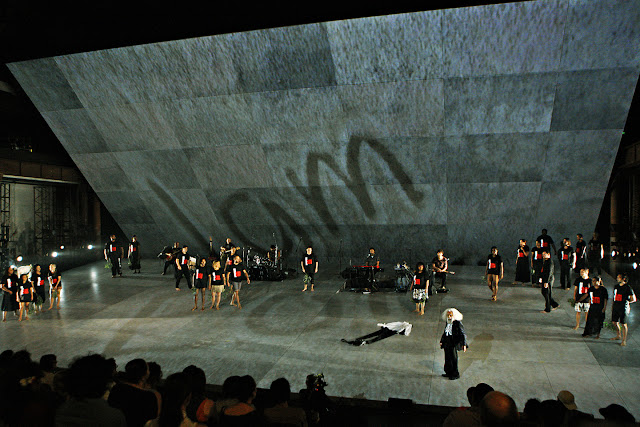Photos by Prudence Upton
Reviewed by Frank McKoneJanuary 12
Described in the program as World Premiere, I have to say that I Am Eora is a show still in need of further development before I would give it such an impressive introduction.
The theme of a new way of finding reconciliation between Aboriginal and the European cultures, of Sydney in particular, is of very great importance. The essential point is to understand that the land of the Eora is still here – Aboriginal land was, is, and always will be. Time – the past, present and future – changes, and the stories of the people living change with it. But the land is permanent. In this sense we are all Eora.
Wesley Enoch has put this in the program notes as “the most provocative thing we could do was to issue an invitation …How could we create a world where everyone living in Sydney could say I Am Eora…I am from this place?”
However, I found the presentation of three well-known stories of Eora heroes from the invasion period – Pemulwuy, The Warrior, who died in action; Barangaroo, The Nurturer, who stood for maintaining culture, stood up for political and economic rights, and died soon after childbirth; and Bennelong, The Interpreter, who sought to create understanding across the cultural divide – was powerful only in patches. As I am currently reading Kim Scott’s novel That Deadman Dance I can’t help seeing the strength of his oblique poetic writing which creates imagery and feeling from his Aboriginal characters’ perspective as a great contrast to the often too literal representation of Pemulwuy and Barangaroo in I Am Eora, though it is true that there is strength in the old Bennelong’s philosophy and death.
On the other hand, Enoch has written “I Am Eora has broken the mould in so many ways. It pioneers new ways of making Indigenous theatre [and] hopes to redefine Indigenous theatre and celebrates the resilience of a community.” It does this by using music and songs in non-Aboriginal forms, such as rap, rock, blues, some almost Pacific Island style, most of which works well as individual items. Dance, often in mimetic form, is also used extensively to illustrate in movement the words spoken and sung. Speeches were also used, such as the Inaugural Speech of the first Indigenous (also a woman) to serve in the New South Wales Parliament, Linda Burney. The skillion stage design, as the photo shows, was simple in concept and very effective for projections of images and text on both the floor space and the backdrop, which seemed to me to represent the overhanging caves in which I have seen many examples of magnificent art work.
My concern though is that it seemed the story–line of this history was that Aboriginal people survive, even after disease, genocidal massacres and the removal of their children, by being adaptable and taking on features of the European culture; while for the Europeans (or rather, in today’s Sydney, people from dozens of non-Indigenous cultures) there was little of Aboriginal culture for them to adapt to.
I sensed, especially from the audience reaction, that the main point of real contact between the two sides was the presentation of the gutsy strength of Aboriginal women in dealing with men. Elaine Crombie’s piece as The Bride was the point when people were stirred into real excitement. This was the moment of the WOW factor which the show needed as a whole rather than only in parts. There was nothing, for example, quite like Gurrumul Yunupingu’s songs and singing style in English and in language which would have been the show-stopper I Am Eora needs, nor dance which creates meaning beyond illustration, such as we often see from Bangarra.
So, although the house was full the night I attended, the audience response at the end was more muted than the theme of this work deserves. I think this Festival presentation should be seen as a trial run, and I hope the Balnaves Foundation can see its way to continuing its support for development to the point of a new World Premiere which might take Sydney and the world by storm.
© Frank McKone, Canberra













